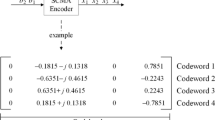Abstract
In space-division multiple access (SDMA), different beamforming or space-domain precoding techniques can be applied. We investigate two different space-domain precoding methods, the maximum capacity (MC) and the minimum mean square error (MMSE) precoders, for the downlink channel. It is shown that the MMSE precoding, which is practically implementable, can provide a reasonable performance in terms of the capacity and error probability, while the MC precoding is not practical (although it is optimum in terms of the capacity). Space-domain precoding methods are also applied to code-division multiple access (CDMA) systems.
Similar content being viewed by others
References
H.R. Karimi, M. Sandell, and J. Salz, “Comparison between transmitter and receiver array processing to achieve interference nulling and diversity”, in Proceedings of PIMRC’99, September 1999, pp. 997–1001.
E. Visotsky and U. Madhow, “Optimum beamforming using transmit antenna arrays”, in Proceedings of IEEE VTC’99, May 1999, pp. 851–856.
G. Montalbano and D.T.M. Slock, “Matched filter bound optimization for multiuser downlink transmit beamforming”, in Proceedings of the IEEE ICUPC, October 1999, pp. 677–681.
B.R. Vojcic and W.M. Jang, “Transmitter precoding in synchronous multiuser communications”, IEEE Trans. Commun., Vol. 46, pp. 1346–1355, 1998.
G.S. Rajappan and M. Honig, “Signature sequence adaptation for DS-CDMA with multipath”, IEEE J. Selected Areas Commun., Vol. 20, pp. 384–395, 2002.
J. Choi, “Interference mitigation using transmitter filters in CDMA systems”, IEEE Trans. Veh. Tech., Vol. 51, pp. 657–666, 2002.
G.J. Foschini and M.J. Gans, “On limits of wireless communications in a fading environment when using multiple antennas”, Wireless Personal Commun., Vol. 6, pp. 311–335, 1998.
I.E. Telatar, “Capacity of multi-antenna Gaussian channels”, Tech. Rep., Bell Labs, Lucent Technologies, 1995.
F.R. Farrokhi, G.J. Foschini, A. Lozano, and R.A. Valenzuela, “Link-optimal space–time processing with multiple transmit and receive antennas”, IEEE Commun. Lett, Vol. 5, pp. 85–87, 2002.
G.H. Golub and C.F. Van Loan, Matrix Computations, The John Hopkins University Press, Baltimore, MD, 1983.
Author information
Authors and Affiliations
Corresponding author
Additional information
This work was supported by the HY-SDR Research Center at Hanyang University, Seoul, Korea, under the ITRC Program of MIC, Korea.
Jinho Choi was born in Seoul, Korea. He recieved the B.E. degree (magna cum laude) in electronics engineering from Sogang University in 1989 and the M.S.E. and Ph.D. degree in electrical engineering from the Korea Advanced Institute of Science and Technology in 1991 and 1994, respectively. Currently he is a Senior Lecturer in the School of Electrical Engineering and Telecommunications,University of New South Wales, Australia. Dr. Choi received the 1999 Best Paper Award of Signal Processing from EURASIP.
Seungwon Choi received the B.S. degree from Hanyang University, Seoul, Korea, in 1980 and the M.S. degree from Seoul National University, Seoul, in 1982, both the electronic engineering. He received the M.S. degree in computer engineering in 1985 and the Ph.D degree in electrical engineering in 1988 from Syracuse University, Syracuse, NY.
From 1982 to 1984, he was with LG Electronics Co. Ltd., Seoul, where he helped developed the 8-mm camcorder system. From 1988 to 1989, he was with the Department of Electrical and Computer Engineering, Syracuse University, as an Assistant Professor. In 1989, he joined the Electronics and Telecommunications Research Institute, daejeon, Korea, where he developed the adaptive algorithm for real-time application in secure telephone systems. From 1990 to 1992, he was with yhe Communication Research Laboratory, Tokyo, Japan, as a science and Technology Agency Fellow, developing adaptive antenna array system and adaptive equalizing filters for applications in land-mobile communications. He joined Hanyang University, Seoul, in 1992 as an Assistant Professor. He is a Professor in the School of Electrical and Computer Engineering, Hanyang University. His research interests include digital communications and adaptive signal processing with a recent focus on the real-time implementation of smart antenna system for 3G mobile communication system.
Rights and permissions
About this article
Cite this article
Choi, J., Choi, S.W. On Downlink Beamforming Methods: Capacity and Error Probability Performance. Wireless Pers Commun 30, 13–26 (2004). https://doi.org/10.1007/s11277-004-1639-2
Issue Date:
DOI: https://doi.org/10.1007/s11277-004-1639-2




